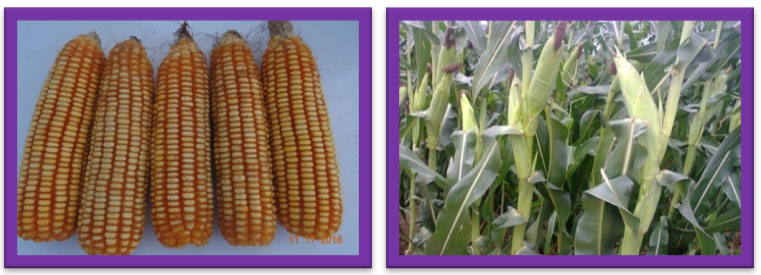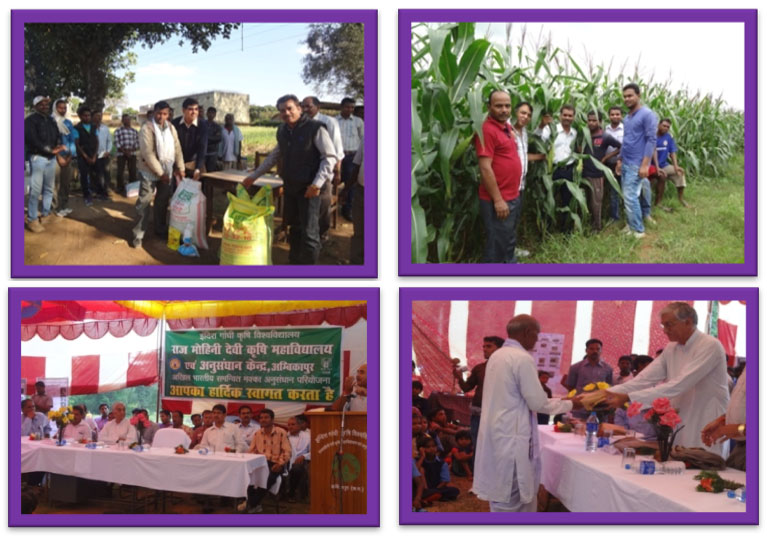Name of centre : Raj Mohini Devi, College of Agriculture & Research Station, Ajirma Ambikapur
Address : Indira Gandhi Krishi Vishwavidyalaya, RMD college of Agriculture & Research Station, Ambikapur-497001 (C.G.)
Latitude : 2008’N
Longitude: 83015’E
Altitude : 592.62 m MSL
Staff details :
| SN | Post | Person occupying the post | Period |
| 1. | Maize Breeder | Dr. S. K. Sinha | July 2008 to continue |
| 2. | Astt. Maize Agronomist | Dr. A. K. Sinha | 2003 to continue |
| 3. | Technical Assistant | Sh. Dinesh Kumar Thakur | October 2014 to continue |
| Sh. Akhilesh Kumar Lakra | October 2014 to continue |
Mandate :
- Identification of early and medium duration single cross hybrid of normal and specialty maize.
- Development of package practices for kharif and rabi seasons.
Farm area :
110 acres (out of these 10 acres area is under AICRP maize)
Significant achievements :
- The centre has successfully conducted, monitored and reported all the allotted trials (Maize Crop breeding and agronomy) of IIMR.
- Recommendations are being made on suitable maize hybrids for state.
- Station developed medium duration maize hybrid IAHM 2015-45 (Grain Yield – 60 to 65 qtls/ha) performed well in zonal trial of AICRP zone-5; in public-private-participation trial in state (during kharif 2016) and in station trial during kharif 2015 & kharif 2016.

- Station developed maize hybrid IAHM 2015-104 (6042 kg/ha) ranked first in trial ZT 501 (CWZ-kharif 2016) and has 11.4% superiority over Pratap Makka 9 (5426 kg/ha). Similarly in trial ZT 502 (CWZ-kharif 2016) entry IAHM 2015-85 (6526 kg/ha) ranked IInd, IAHM 2015-52 (6430 kg/ha) ranked IIIrd and IAHM 2015-45 (6071 kg/ha) ranked 9th .They have the yield superiority of 20.4%, 18.6% and 12.0% respectively over check Pratap Makka 9 (5420 kg/ha) under rainfed condition.
- Station developed maize hybrid IAHM 2016-38 (5380 kg/ha) ranked 9th in national zonal trial of zone 5 and is significantly superior to check Pratap Makka 3 (4130 Kg/ha, 30th rank) but at par with checks Pratap Hybrid Makka 3 (5542 Kg/ha, 4th rank) and Pratap Makka 9 (5437 Kg/ha, 5th rank) under rainfed. The centre has 89 own developed inbred lines and out of which 32 have also been contributed in WNC, Hyderabad.
- The centre also nominated entries in national Forage maize trials. Two entries IAFM 2015-38 and IAFM 2015-48 have been advanced from IVT to AVT (kharif 2016). IAFM 2015-38 (332.2 qtls green fodder/ha) ranked Ist in Hill Zone only and has yield superiority of 2.4% over J1006 (National Check) during kharif 2016.
- The centre has successfully produced 8.5 qlts Hybrid maize seed of Shaktiman-2 and distributed to tribal farmers.
- Reactions of centre contributed maize inbred lines were found promising – For TLB- IAMI 31, IAMI 34, IAMI 57, IAMI 83 (R) and For MLB- IAMI 34, IAMI 83 (MR).
- Effect of planting density and nutrient management practices on the performance of hybrids in Maize – mustard system: Based on two years trial, Maximum grain yield was obtained from Bio 9637, plant density of 60 X 20 cm and site specific nutrient management system. In case of maize – mustard system, maximum system productivity (11016.00 in 2015 and 10618.00 kg/ha in 2016 in terms of maize equivalent yield) and net return (Rs 102734.00 in 2015 and Rs 97249.00 in 2016) obtained from SSNM which was at par with STCR but significantly superior to RDF.
- Intercropping in sweet corn (Zea mays L.) at varying crop geometry for higher economic profitability in northern hills of Chhattisgarh: Intercropping of sweet corn with different row arrangements significantly increased sweet corn-equivalent yield as compared to sole sweet corn. Maximum sweet corn-equivalent yield (21.21 t/ha), net return (Rs. 175340.2/ha) and BC ratio (4.78) was recorded under paired combination of sweet corn and coriander (2:3). Data further revealed that maximum LER (1.84) was recorded under paired combination of sweet corn and french bean (2:2) followed by paired combinations of sweet corn + coriander (2:3) and sweet corn + fenugreek (2:3) which had land equivalent ratio of 1.62 and 1.48, respectively.

- System productivity, profitability and soil health as influenced by sowing schedule and integrated nutrient management in rainfed baby corn (Zea mays L.) – horse gram (Macrotyloma uniflorumL.) cropping sequence: Based on two years trials (kharif 2012 and 2013) maximum baby corn yield (1924 kg ha-1) and green fodder yield (33 tones ha-1) were obtained from crop sown during 1st week of July at fertility level of 100:60:40 + 5 t FYM. In the mean time, horse gram (kulthi) was sown as utera crop just before harvesting of baby corn. Combined effect of sowing of first schedule of baby corn and horse gram and application of 125% RDF + 5 t FYM recorded significantly higher system productivity (2.8 t/ha).

- Evaluation of the interactive effect of plant density, geometry (equal spaced and paired rows) on the productivity of early maturing genotype: Based on two years trials, Paired row of maize at 84/50 cm in combination with 03 rows of soybean was very remunerating proposition and having maximum system productivity (7548 kg ha-1) with 5 tonnes FYM.
- Ecological intensification: Maximum maize kernel yield (6.75 t ha-1), net return (Rs. 69326.00) and B:C ratio (2.18) were obtained from ecological intensification treatment (best cultivation technique) and minimum grain yield was obtained from ecological intensification without weed management practices (3.6 t ha-1). Ecological intensification treatment was at par with EI without water management and disease & insect management whereas significantly superior than EI without tillage practices, nutrient management, plant density management and weed management in terms of grain yield, net return and B:C ratio.
- System productivity and profitability : Sweet corn (at 50 cm X 20 cm and 75% RDF + 5 t vermicompost) along with horse gram sown as utera crop (sowing of horse gram was done 1 week before harvesting of sweet corn) produced maximum system productivity in terms of sweet corn-equivalent yield (26.86 t ha-1), net profit (Rs. 2.28 lakh ha-1) and benefit-cost ratio (5.66) suitable for farmers of Northern hills of Chhattisgarh and make sweet corn available for market along with horse gram which is the main source of pulses (protein) for tribal peoples under System productivity and profitability.
- The centre has successfully conducted many front line demonstrations in farmers field mostly of them are tribal farmers during the period under ISOPOM; NFSM & TSP. Field day/ kisan diwas were also organized.

Honourable MLA Ambikapur Shri T.S. Singhdeo, chief guest in Field day function
- The centre has sent group of tribal farmers 20 times (total tribal farmers – 115) of this region to IIMR New Delhi (Now Ludhiana) for training on different aspects of the maize production technology.
- The centre has conducted many training programmes on improved maize production technology. These trainings were given to SADO, ADO & RAEO of agriculture department and farmers of the region. Tribal farmers of the region were participated. Inputs (Hybrid seed, Fertilizers, weedicide atrazin etc.), equipments, implements (Seed treating drum, knapsack sprayer, lapeta pipe, hand maize sheller etc.) were distributed to tribal farmers.

Disease management
Major diseases of maize in this state are Turcicum Leaf blight and Banded leaf and sheath blight.
Control measures of TLB : application of carbendazim 0.1%.
Control measures of BLSB : application of sheathmar 0.3%.
Pest management –
Earlier stem borer was the major pest in both kharif and rabi season, but now Fall Army Worm (FAW) is causing severe damage to the crop.
Control measures of Stem borer : application of Phorate 10%, 10 kg/ha
Control measures of BLSB : application of Emamectin Benzoyate 5 SG @ (0.4 g/l) or Chlorntrinilprole 0.4 ml/l

